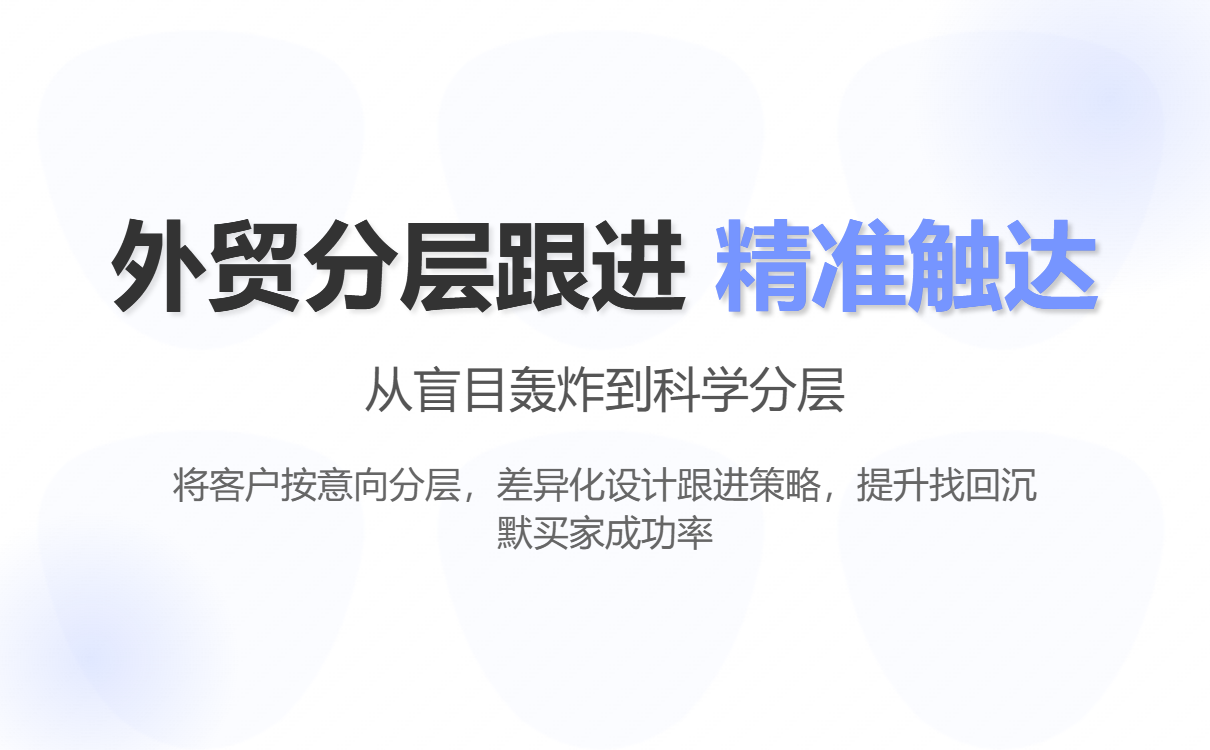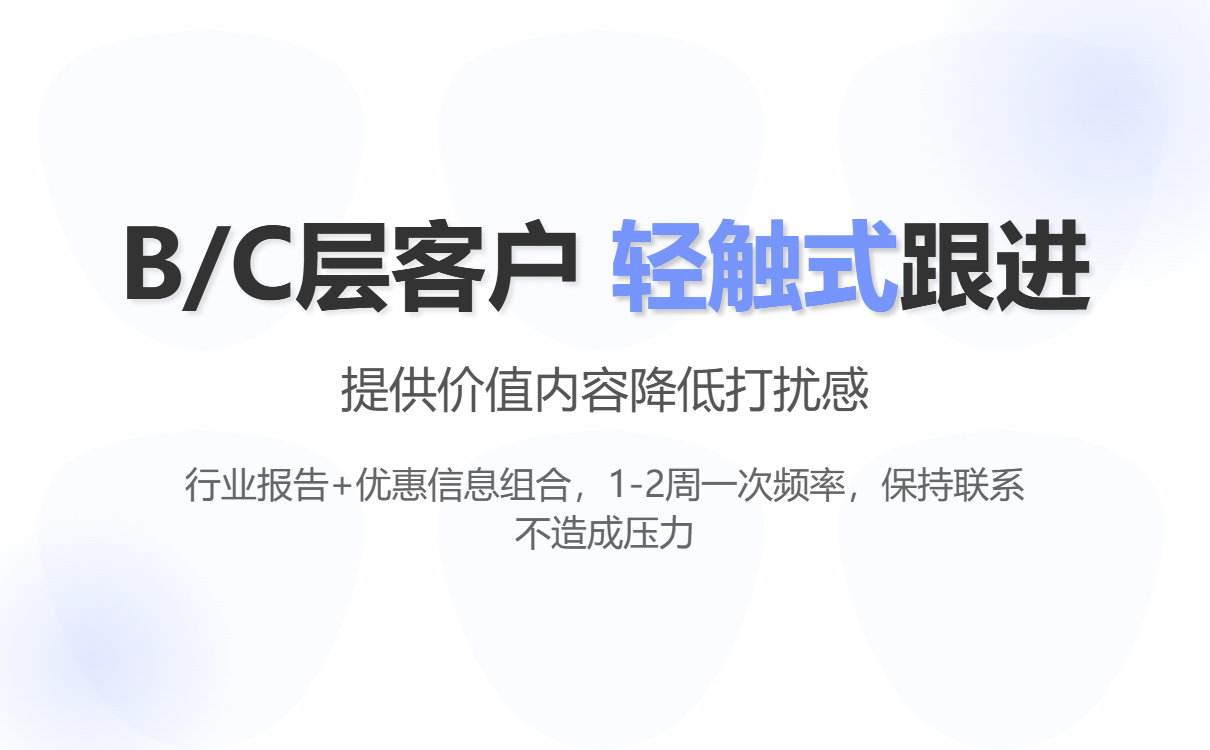
In practical foreign trade, many beginners have encountered this situation: a customer they were chatting with enthusiastically suddenly disappears, not replying to emails or answering calls. There are many reasons why a buyer might go silent: being busy, having a tight budget, encountering competitors, or hesitating about pricing. However, as a newcomer to foreign trade, if you don't understand a systematic follow-up strategy , you may easily lose this opportunity. This article will use examples to break down the "layered follow-up" method in detail, helping you win back silent buyers.
"Tiered follow-up" involves segmenting customers based on their behavioral status, likelihood of a sale, and urgency of follow-up, and then designing different follow-up strategies for each segment. The core concepts are differentiation, precision, and continuity , avoiding indiscriminate email bombardment and increasing the success rate of reconnecting with dormant buyers.

Commonly used stratification criteria:
| hierarchy | feature | Follow-up strategy |
|---|---|---|
| Level A: High-intent customers | Recent frequent responses, with specific and clear inquiries. | We provide immediate follow-up and personalized solutions via both phone and email. |
| Level B: Potential Clients | They replied before, but have been silent for 3-7 days recently. | Emails with valuable content reminders, focusing on pain points or special offers. |
| Level C: Low-intent customers | No reply for a long time (more than 7 days), or only initial inquiry | Easy-to-use follow-up, providing case studies/industry data, reducing intrusion. |
| Layer D: Lost Customers | No response after multiple attempts | Pause follow-up and set up periodic wake-up (e.g., once a month). |
The principle of segmentation: For customers who are more likely to make a purchase, the follow-up frequency should be higher; for customers with lower intentions, the follow-up approach should be gentler.
Background : You are a newcomer to foreign trade, responsible for selling industrial pump and valve equipment. The client, "ABC Company," was initially very proactive, inquiring about product quotations and technical parameters, but has not responded for five consecutive days after sending the quotation.
Recent customer behavior: Specific inquiries, mentioning technical requirements → High interest (Level A)
Key factor: The quote has been sent, but there has been no response → This may be due to budget constraints or hesitation from decision-makers.

Step 1: Follow up by phone (within 48 hours)
Key points:
Self-identification: Hello, I am XX from XXX company. I would like to confirm whether you received the previous quote.
Show concern, not pressure: Find out if there are any technical or budgetary questions.
Example script:
"Hello, Mr. Zhang, this is Liu from XXX company. Did you see the pump and valve quote I sent last time? I'd like to confirm if there are any parameters or solutions that we need to optimize?"
Step 2: Follow up via email (if phone calls are not answered or not replied to)
The email subject line should be eye-catching:
"Optimized solutions tailored to your needs – ABC Company's exclusive quote"
Email content:
Value provided: Optimized technical solutions or pricing options based on customer needs.
Urgency reminder: Limited stock, price expiration date.
Closing action: Invite for a phone or video call.
Step 3: Supplementing Value Content
You can send industry case studies, customer success stories, product usage screenshots or videos to increase trust.
Step 4: Periodic Summary
If there is still no response after one week, provide a clear next step:
"If it's convenient, I will contact you again this Friday to confirm if you have any further needs."
Give customers psychological space while retaining the initiative.

Example : Customer "DEF Company" made an initial inquiry but has not responded for more than a week.
Email content :
Provide market or industry reports so that clients can experience the value of the information.
Offers optional promotional information, such as new product launches and discount policies.
Sending frequency : once every 1-2 weeks to avoid frequent interruptions.
Stratified decision-making should be precise
Use AB Customer CRM to record customer behavior: opening emails, clicking links, inquiry frequency, etc.
Use data to assess customer status and avoid blindly following up based on feelings.
The content to be followed up must be "valuable".
In addition to quotations, we can provide technical optimization solutions, industry case studies, market trends, and customer testimonials.
Make customers feel that follow-up is to help them make a decision rather than to urge them to buy.
Multi-channel combination use
Use a combination of email, phone, and social tools such as LinkedIn/WhatsApp to increase reach.
For important clients, prioritize phone calls; for clients with minor interest, emails are preferable.
The frequency of follow-up should be scientific.
Highly interested clients: once every 1-2 days, for 1-2 weeks.
For potential clients: once every 3-5 days
Low-intent customers: once every 1-2 weeks
Keep records and review
After each follow-up, record feedback in the CRM to assess changes in customer interest.
Regularly review and adjust the tiered strategy and follow-up methods.
Psychological strategy: Combining patience with a sense of urgency
Neither be anxious and blindly urge, nor completely ignore the situation.
Give customers psychological space while creating a slight sense of urgency (discounts, inventory, and price expiration dates).
More tips for following up with foreign trade clients:
For novice foreign traders facing silent buyers, the key is not frequent bombardment, but rather tiered follow-up, providing precise value, and scientifically arranging the frequency of outreach .
Practical formula:
Layered assessment → Tailored follow-up → Providing value → Continuous review → Timely activation
If implemented systematically, even if a customer disappears temporarily, the recovery rate can be effectively improved, increasing the chances of closing the deal.
.png?x-oss-process=image/resize,h_100,m_lfit/format,webp)
.png?x-oss-process=image/resize,h_100,m_lfit/format,webp)

.png?x-oss-process=image/resize,h_100,m_lfit/format,webp)
.png?x-oss-process=image/resize,h_100,m_lfit/format,webp)
.png?x-oss-process=image/resize,h_100,m_lfit/format,webp)
.png?x-oss-process=image/resize,h_100,m_lfit/format,webp)
